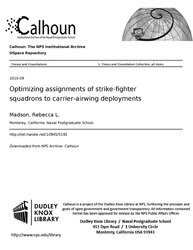File:Optimizing assignments of strike-fighter squadrons to carrier-airwing deployments (IA optimizingssignm109455192).pdf

Original file (1,275 × 1,650 pixels, file size: 918 KB, MIME type: application/pdf, 64 pages)
Captions
Captions
Summary[edit]
| Optimizing assignments of strike-fighter squadrons to carrier-airwing deployments
( |
||
|---|---|---|
| Author |
Madson, Rebecca L. |
|
| Title |
Optimizing assignments of strike-fighter squadrons to carrier-airwing deployments |
|
| Publisher |
Monterey, California. Naval Postgraduate School |
|
| Description |
The Department of the Navy currently has 11 nuclear-powered aircraft carriers (CVN), which are the centerpiece of carrier strike groups (CSG). The Fleet Response Plan (FRP) dictates CSG deployment and readiness cycles. Based on the FRP, the Navy produces a Master Aviation Plan that assigns 10 carrier-airwings (CVW) to CVNs and carrier-based squadrons to CVWs. At any given time, there are at most 38 strike-fighter squadrons to fill 40 possible assignments. Because there are not enough to fill every possible assignment at one time, strike-fighter squadrons must move between carrier-airwings. Currently, heuristics determine moves using a set of predetermined rules. This thesis presents the Carrier Optimal Strike-fighter Scheduling Tool (COSST), which uses an integer-linear program that optimally assigns strike-fighter squadrons to carrier-airwings over a 10-year period. Assignments minimize moves and ensure sufficient time between deployments. Compared to an existing schedule, our analysis shows that COSST reduces the number of strike-fighter squadron moves from eleven to five in the first four years. Our analysis also examines the impact of reducing strike-fighter squadron availability and transitioning squadrons. Subjects: Scheduling |
|
| Language | English | |
| Publication date | September 2010 | |
| Current location |
IA Collections: navalpostgraduateschoollibrary; fedlink |
|
| Accession number |
optimizingssignm109455192 |
|
| Source | ||
| Permission (Reusing this file) |
This publication is a work of the U.S. Government as defined in Title 17, United States Code, Section 101. As such, it is in the public domain, and under the provisions of Title 17, United States Code, Section 105, may not be copyrighted. | |
Licensing[edit]
| Public domainPublic domainfalsefalse |
This work is in the public domain in the United States because it is a work prepared by an officer or employee of the United States Government as part of that person’s official duties under the terms of Title 17, Chapter 1, Section 105 of the US Code.
Note: This only applies to original works of the Federal Government and not to the work of any individual U.S. state, territory, commonwealth, county, municipality, or any other subdivision. This template also does not apply to postage stamp designs published by the United States Postal Service since 1978. (See § 313.6(C)(1) of Compendium of U.S. Copyright Office Practices). It also does not apply to certain US coins; see The US Mint Terms of Use.
|
 | |
| This file has been identified as being free of known restrictions under copyright law, including all related and neighboring rights. | ||
https://creativecommons.org/publicdomain/mark/1.0/PDMCreative Commons Public Domain Mark 1.0falsefalse
File history
Click on a date/time to view the file as it appeared at that time.
| Date/Time | Thumbnail | Dimensions | User | Comment | |
|---|---|---|---|---|---|
| current | 15:27, 23 July 2020 |  | 1,275 × 1,650, 64 pages (918 KB) | Fæ (talk | contribs) | FEDLINK - United States Federal Collection optimizingssignm109455192 (User talk:Fæ/IA books#Fork8) (batch 1993-2020 #24193) |
You cannot overwrite this file.
File usage on Commons
The following page uses this file:
Metadata
This file contains additional information such as Exif metadata which may have been added by the digital camera, scanner, or software program used to create or digitize it. If the file has been modified from its original state, some details such as the timestamp may not fully reflect those of the original file. The timestamp is only as accurate as the clock in the camera, and it may be completely wrong.
| Short title | Optimizing assignments of strike-fighter squadrons to carrier-airwing deployments |
|---|---|
| Author | Madson, Rebecca L. |
| Software used | Madson, Rebecca L. |
| Conversion program | Adobe PDF Library 9.0 |
| Encrypted | no |
| Page size |
|
| Version of PDF format | 1.4 |

